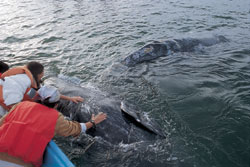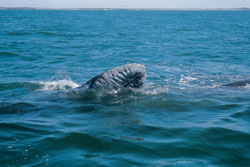Four Whalewatching Sites:
To choose from Baja California
 Baja
California Sur offers four different options for sighting gray whales:
the Ojo de Liebre lagoon in Guerrero Negro and the Laguna de San Ignacio
(both inside the El Vizcaíno Biosphere Reserve), the Soledad
estuary in Puerto Adolfo López Mateos and Puerto San Carlos in
Bahía Magdalena, considered a nature reserve.
Baja
California Sur offers four different options for sighting gray whales:
the Ojo de Liebre lagoon in Guerrero Negro and the Laguna de San Ignacio
(both inside the El Vizcaíno Biosphere Reserve), the Soledad
estuary in Puerto Adolfo López Mateos and Puerto San Carlos in
Bahía Magdalena, considered a nature reserve.
If you happen to be in the vicinity of La Paz and Los Cabos, we recommend visiting Puerto López Mateos or Puerto San Carlos, since they are a three or four hours’ drive away. If you are near the northern border of the state or prefer to fly, why not take the Aerolitoral flight which leaves from Hermosillo, Sonora, and will get you to Guerrero Negro in 40 minutes?
Source: Tips Aeroméxico # 16 Baja California Sur / summer 2002
Four Whalewatching Sites:
To choose from Baja California
By: Sabrina Lear
 The
Baja California peninsula is one of the few places on earth where wintering
gray whales frolic offshore from January through April, captivating
all who witness their playful aquatic ballet. Bottom-feeders and shore
lovers who spend most of their lives traveling, they are known as the
Pacific gray, California gray or grayback. From mid to late fall, they
make the longest migration of any mammal, a 6,000-mile journey from
the Bering and Chukchi Seas of Alaska and Siberia, averaging four to
five knots and traveling nearly 100 miles a day, usually within several
miles of the coastline.
The
Baja California peninsula is one of the few places on earth where wintering
gray whales frolic offshore from January through April, captivating
all who witness their playful aquatic ballet. Bottom-feeders and shore
lovers who spend most of their lives traveling, they are known as the
Pacific gray, California gray or grayback. From mid to late fall, they
make the longest migration of any mammal, a 6,000-mile journey from
the Bering and Chukchi Seas of Alaska and Siberia, averaging four to
five knots and traveling nearly 100 miles a day, usually within several
miles of the coastline.
After a 12 to 13 month gestation period, pregnant females begin arriving in late December to calve in the warm, salty Pacific Ocean lagoons of Ojo de Liebre, San Ignacio, and Bahía Magdalena. Other males and females will spend the season visiting the lagoons and traveling the coast, ranging as far south as the Sea of Cortez.
 Like
all mammals, the gray whale is warm blooded, has hair, breathes air,
and nurses its young. At maturity, males will be smaller than females,
40 to 50 feet long, and weigh up to 73,000 pounds, with a life span
of 30 to 50 years. Gray in color, hence the name, they have barnacle
patches and marks from encounters with their natural predator, the orca,
or killer whale. They are classified as Cetacea, marine mammals that
include whales, porpoises, and dolphins, and belong to Mysticeti, one
of the three families of great baleen whales. Grays have no close relatives;
they are the single species of the family Eschrichtidae. Like other
balaenopterids, instead of teeth they have baleen fringes made of whalebone.
The baleen works like a large comb, filtering nutrients from the salt
water. Grays have a long snout and double blowholes on their heads.
In place of a dorsal fin, the gray has a hump with dorsal ridges running
to its flukes, or tail. The 5,000-acre Laguna San Ignacio part of El
Vizcaíno Biosphere Reserve is the only gray whale calving area
not affected by commercial activity in Mexico. Bahía Magdalena,
several hundred miles from Land’s End, is the most convenient
whale watching location for visitors to Los Cabos and the southern peninsula,
however, the northern lagoons in the protected Biosphere offer more
sightings.
Like
all mammals, the gray whale is warm blooded, has hair, breathes air,
and nurses its young. At maturity, males will be smaller than females,
40 to 50 feet long, and weigh up to 73,000 pounds, with a life span
of 30 to 50 years. Gray in color, hence the name, they have barnacle
patches and marks from encounters with their natural predator, the orca,
or killer whale. They are classified as Cetacea, marine mammals that
include whales, porpoises, and dolphins, and belong to Mysticeti, one
of the three families of great baleen whales. Grays have no close relatives;
they are the single species of the family Eschrichtidae. Like other
balaenopterids, instead of teeth they have baleen fringes made of whalebone.
The baleen works like a large comb, filtering nutrients from the salt
water. Grays have a long snout and double blowholes on their heads.
In place of a dorsal fin, the gray has a hump with dorsal ridges running
to its flukes, or tail. The 5,000-acre Laguna San Ignacio part of El
Vizcaíno Biosphere Reserve is the only gray whale calving area
not affected by commercial activity in Mexico. Bahía Magdalena,
several hundred miles from Land’s End, is the most convenient
whale watching location for visitors to Los Cabos and the southern peninsula,
however, the northern lagoons in the protected Biosphere offer more
sightings.
 For
centuries, indigenous man hunted gray whales for food, maintaining a
natural balance until they were nearly driven into extinction after
Captain Charles Scammon discovered the lagoon we know as Ojo de Liebre
near present day Guerrero Negro in the 1850s. With the advent of the
factory processing ships in the 1920s, gray whales drastically declined
from around 25,000 before Scammon’s discovery, to just several
hundred by the 1930s. The gray whale finally received protection with
the newly formed International Whaling Commission in 1946, making a
remarkable recovery. Removed from the endangered species list in 1994,
and now considered threatened, gray whale populations again number over
25,000. Once found in Europe and Asia, they are now almost exclusively
confined to the North Pacific as far south as Mexico. The opportunity
to pet whales is not uncommon, especially at Ojo de Liebre and San Ignacio.
For
centuries, indigenous man hunted gray whales for food, maintaining a
natural balance until they were nearly driven into extinction after
Captain Charles Scammon discovered the lagoon we know as Ojo de Liebre
near present day Guerrero Negro in the 1850s. With the advent of the
factory processing ships in the 1920s, gray whales drastically declined
from around 25,000 before Scammon’s discovery, to just several
hundred by the 1930s. The gray whale finally received protection with
the newly formed International Whaling Commission in 1946, making a
remarkable recovery. Removed from the endangered species list in 1994,
and now considered threatened, gray whale populations again number over
25,000. Once found in Europe and Asia, they are now almost exclusively
confined to the North Pacific as far south as Mexico. The opportunity
to pet whales is not uncommon, especially at Ojo de Liebre and San Ignacio.
While the gray whale is not the only species you will see-blue, humpback, sperm, Bryde’s, sei, fin, and the occasional orca ply these waters - it is the most commonly sighted whale of the Baja peninsula.
Source: Tips Aeroméxico # 16 Baja California Sur / summer 2002
| |